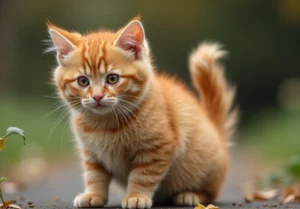Male cats are often referred to as “toms,” but have you ever wondered why? Let’s explore the origins of this term.
Male cats are called toms after Thomas cats, a reference to Thomas male cat commonly used in 18th-century England. This nickname eventually evolved into the shortened version we use today. But why exactly are male cats known as toms? Let’s break it down further.
Historical Origins of the Term “Tom”:
Have you ever wondered why male cats are often referred to as “toms”? The term “tom” actually dates back to 18th-century England, where it was commonly used to describe a male of various animal species. The word “tom” likely originated from the name Thomas, which was a popular name for male cats at the time.
Interestingly, in the 18th century, male cats were sometimes even called “ram-cats” due to their strong and assertive nature, much like a ram. Over time, however, the term “tom” became the more prevalent and widely accepted way to refer to male cats. This historical background sheds light on why male cats are still commonly called “toms” to this day.
Evolution of the Name “Tomcat”:
Moving forward in history, the term “tomcat” emerged as a popular way to specifically refer to male cats. The addition of “cat” to “tom” further solidified the distinction between male and female felines. The term “tomcat” emphasizes the masculine nature of male cats, highlighting their independent and sometimes feisty characteristics.
As language continued to evolve, “tomcat” became the standard way to refer to male cats in modern times. The term is now widely recognized and understood, making it easy to identify male felines in everyday conversation. So, the next time you come across a male cat, you’ll know exactly why they are called “tomcats.”
Gender-specific Nicknames for Cats:
Throughout history, there has been a distinction between male and female cat names, with male cats often being referred to as “toms.” This tradition likely stems from the term “tomcat,” which originated in the 16th century to refer to male cats. The name “tomcat” is thought to have derived from the ancient word “tom,” meaning male. This gender-specific naming convention has been upheld over time to differentiate between male and female cats easily. Interestingly, female cats are often named “queens” to reflect their nurturing and regal nature, further solidifying the distinction between genders in cat naming traditions.
Influence of Popular Culture:
Popular culture has played a significant role in influencing the use of the term “tomcat” and its portrayal in various forms of media. In literature and folklore, tomcats are often depicted as independent, adventurous, and sometimes mischievous, contributing to the association of the term with male cats in general. Additionally, in movies and TV shows, tomcats are frequently portrayed as brave and cunning characters, further cementing the idea of male cats as bold and resourceful. The widespread use of the term “tomcat” in popular culture has reinforced its association with male felines, contributing to the ongoing tradition of calling male cats “toms.”
Unique Insight: Famous literary works like “The Adventures of Tom Sawyer” by Mark Twain have further popularized the name “Tom” as a symbol of adventure and mischief, subtly influencing the perception of male cats as adventurous and independent like the character Tom Sawyer.
Unique Traits of Male Cats:
Male cats, often referred to as “toms,” possess unique characteristics that set them apart from their female counterparts. One distinct trait is their territorial nature, with male cats being more likely to mark their territory with scent glands to ward off potential rivals. Additionally, male cats tend to be more independent and adventurous, roaming further from home in search of new territory or potential mates. These behaviors may have contributed to the nickname “tom,” which has been used colloquially to refer to male cats for centuries.
Popular Male Cat Names:
When it comes to naming our furry friends, male cats have been given a variety of names throughout history. While traditional names like “Tom” and “Toby” remain popular choices, modern cat owners are getting creative with names like “Simba,” “Oliver,” and “Leo.” The nickname “tom” continues to be a classic choice for male cats, reflecting their strong, independent nature. Whether you opt for a timeless name or a more unique moniker, the most important thing is to choose a name that suits your cat’s personality and charm.
- Max
- Charlie
- Jasper
- Gizmo
- Felix
Remember, the name you choose for your male cat should not only be meaningful to you but also reflect their individuality and spirit. So, whether you go with a classic name like “Tom” or something more modern like “Leo,” make sure it resonates with both you and your feline companion.
Cultural Significance of Cat Nicknames:
Have you ever wondered why male cats are often referred to as “toms”? The term “tomcat” dates back to the Middle Ages when the name “Tom” was commonly used as a generic term for any male. Over time, this evolved into “tomcat,” specifically referring to male cats. This cultural association with the name “Tom” has stuck around, giving male cats a distinct nickname that reflects a historical naming convention. Our relationship with these beloved pets is further reflected in the variety of nicknames we use for cats, showcasing the special bond humans share with their feline friends. From “Fluffy” to “Whiskers,” cat nicknames often embody the unique personalities and characteristics of our furry companions, adding a touch of endearment and familiarity to our interactions with them.
The Future of Male Cat Nicknames:
As society continues to evolve, so too may the way we refer to male cats. While “tom” has been a longstanding and traditional nickname for male cats, the future may see a shift towards more modern and creative names. Pet owners are increasingly choosing unique and personalized names for their feline friends, reflecting their individuality and personality. With the rise of social media and viral pet trends, the naming of male cats may become more influenced by pop culture and internet phenomena. However, classic names like “tom” may also stand the test of time, serving as a timeless and enduring choice for male cat owners. Whether you opt for a traditional moniker or a contemporary name, the most important thing is to choose a name that resonates with you and your furry companion on a personal level.
Additional Unique Insight:
As pet owners become more conscious of gender stereotypes and norms, the usage of gender-neutral or non-binary names for male cats may become more prevalent in the future. Names that defy traditional gender expectations can be a powerful way to celebrate individuality and challenge societal conventions. Choosing a name that reflects your cat’s personality and spirit, regardless of traditional gender associations, can be a meaningful and progressive way to honor your feline friend’s unique identity. Consider unconventional options like “Sunny,” “Bean,” or “Pumpkin” that focus on your cat’s individuality rather than conforming to traditional gender norms.
Alex, a passionate animal lover, has experience in training and understanding animal behavior. As a proud pet parent to two dogs and three cats, he founded AnimalReport.net to share insights from animal experts and expand his knowledge of the animal kingdom.




